| COVID-19(新型コロナウイルス感染症 情報:渡航制限 有効です。国境は、ブルガリア、ルクセンブルグ、ポルトガル、ルーマニア、スウェーデンを除く他のEUおよびシェンゲン協定加盟国からの旅行者に開放されています。また、オーストラリア、中国、日本、ニュージーランド、韓国からの旅行者はスロバキアに入ることができます。詳細については、 reopen.europa.eu. | |
| (情報の最終更新日は2020年8月11日) |
スロバキア (スロバキア: スロバキア) または スロバキア共和国 (スロバキア共和国)は 中央ヨーロッパ。スロバキアを訪れる主な理由は、その自然の美しさ、鮮やかな歴史、そしてリラックスする絶好の機会です(そして国のサイズが小さいため、3つすべてを組み合わせるのは非常に簡単です)。
スロバキアには9つの国立公園があり、国の比較的大きな部分をカバーし、カルパティア山脈の最も高い部分である ハイタトラス、山と冬のスポーツだけでなく、素晴らしい景色のための素晴らしい機会を提供します。地質学的には、スロバキアのかなりの部分が石灰岩でできており、多くの泉や川と組み合わさって、多数の洞窟(12は一般公開され、そのうちのいくつかはユネスコに登録されています)と美しい岩の形成、峡谷、の滝 スロバキアパラダイス そして スロバキアカルスト。これらの地域の外でも、いくつかの美しい風景があり、スロバキアのすべては、何千ものよくマークされたハイキングコースで覆われています。
歴史愛好家にとって、スロバキアには、単純な遺跡から家具付きの保存状態の良い居住可能な城まで、世界で最も多くの城と一人当たりの城があります。中世の歴史のファンなら、もう探す必要はありません。たくさんあります ゴシック 首都を含むスロバキア全土のバロック様式の都市や町。完全に木で作られた教会や世界で最も高い木造の祭壇など、保存状態の良い木造の民俗建築の例もあります。
スロバキアには数多くのミネラル温泉と温泉があり、これらの世界的に有名なスパのいくつかの周りには、素晴らしい治療法や単純なリラクゼーションを提供するように建てられています。また、いくつかの地元の湖やプールのほとりでリラックスしたり、泳いだり、日光浴をしたり、もっと冒険したい場合はAquaCityウォーターパークを試すこともできます。特に、 ブラチスラバ 賑やかなナイトライフも自慢で、人気のパーティースポットです。
地域
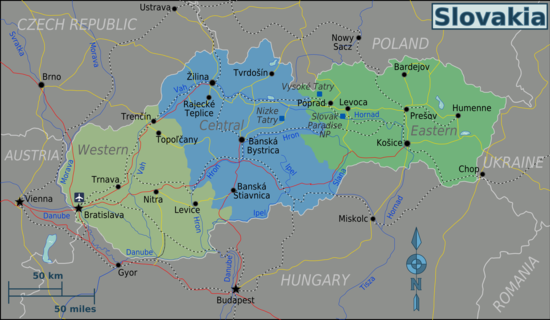
| 西スロバキア ここの観光は首都に焦点を当てています ブラチスラバ とそのすぐ近く。南部地域は、国内で最も肥沃な地域であるドナウ川沿いの大平原です。北は、樹木が茂った山々で区切られたヴァー川とニトラ川の広い谷で構成され、 ニトラ, トレンチーン または Bojnice. |
| 中央スロバキア の中心部にある地域 カルパティア山脈。いくつかのウィンタースポーツエリアがここにあります。 ジャスナ。いくつかの国立公園もあります、 低タトラ, グレートファトラ, リトルファトラ など。主な都市は バンスカービストリツァ そして ジリナ、しかし、いくつかの鉱山の町もあります-ユネスコのリストのように バンスカー・シュティアヴニカ. |
| 東部スロバキア の地域 ハイタトラス 山、頂上 カルパティア山脈、および スロバキアパラダイス、渓谷ハイキングの楽園。それはの町が含まれています レボチャ そして バルデヨフ、ユネスコに登録されています-そして国の大多数の木造教会。主な都市は コシツェ、出向 プレショフ. |
都市
- 1 ブラチスラバ —首都であり、ゴシック、バロック、ルネッサンスの教会、家と宮殿、石畳の通り、噴水、快適なカフェ、活気に満ちた国際的な雰囲気に満ちた美しく修復された歴史的中心部があるスロバキア最大の都市
- 2 バンスカービストリツァ —オーストリア=ハンガリー帝国のハンガリーの一部で最も重要な鉱山の町の1つでした。美しい復元された広場、多くの教会、城、美術館、スロバキア国民蜂起の記念碑
- 3 コシツェ —東の大都市、世界で最も東に位置するゴシック様式の大聖堂、ヨーロッパ最古の紋章、大聖堂のある素晴らしい歴史的な市内中心部、数多くの教会、宮殿、興味深い美術館がある、国で2番目に大きな都市。
- 4 ニトラ —美しい城と多くの見本市があるスロバキア最古の町
- 5 ポプラト —ハイタトラスへの入り口
- 6 RajeckéTeplice —壮大なマラファトラ国立公園に囲まれたとても静かな温泉街
- 7 トレンチーン —歴史的中心部とヴァー川を見下ろす街の上に城が横たわっている最も美しいスロバキアの町の1つ
- 8 —教会の数が最も多く(12)、保存状態の良いバロック建築の古いスロバキアの町
- 9 ジリナ —ドイツの建築に影響を受けた、保存状態の良い歴史的な市内中心部と、ブダティン城にあるいじくり回す文化のユニークな博物館がある4番目に大きな都市
その他の目的地

- 1 スロバキアパラダイス国立公園 — スロバキアラージ 石灰岩を通って滝に流れ落ちる水によって作成された深い峡谷と峡谷で構成されています。
- 2 ハイタトラス — ヴィソケー・タトリ スロバキア最大の国立公園であり、ウィンタースポーツやハイキングの中心地です。
- 3 ヴルコリニェク — ユネスコ 伝統的なカルパティアの村の特徴を維持した遺産リストの村
- 4 スロバキアカルスト 国立公園 - スロバキアのクラス、ユネスコの世界遺産の一部である洞窟システムで知られています
- 5 レボチャ —独特のルネッサンス様式の市庁舎、ハンバーガーの家、数多くの教会、世界最大のゴシック様式の木造祭壇があるセントジェームス大聖堂のある町の壁に囲まれたスピシュ地方の壮大な中世の真珠
- 6 Bojnice —スロバキアで最も訪問された城で、内部は美しく保存されており、ほとんど無傷です。
- 7 ピエシチャニ —スロバキアで最も有名な温泉街
- 8 スピシュ城 —で最大の城の1つ ヨーロッパ と ユネスコ 世界遺産。
- 9 バルデヨフ —はスロバキア北東部の温泉街で、完全に無傷の中世の町の中心部に数多くの文化的モニュメントがあり、 ユネスコの世界遺産。
理解する
スロバキアは現代の民主主義国であり、欧州連合の加盟国です。
地形
スロバキアの中央部と北部の多くは険しく山岳地帯です。 Gerlachovskýštít、2,655 m(8,711フィート) ハイタトラス 最高峰です。ザ・ タトラ山脈 ポーランドと共有されている北部には、多くの美しい湖や谷が点在しています。これらの地域は気温が低く、伝統的にここの人々は羊の放牧で暮らしていました。
低地は南にあり、ボドロッグ川の最低地点は海抜94 m(308フィート)です。ここの土壌は、特に小さなドナウ川とドナウ川の間の地域ではるかに肥沃で、より農業的でした。天候は穏やかで、特に夏は驚くほど暖かくなります。
歴史
現在のスロバキアである地域は、旧石器時代初期から定住しています。スラブ人とフン族が内向きに移住する前は、最も重要な文化はケルト人とローマ人でした。今日まで、これらの文化の存在の遺物と証拠を見つけることができます。
5世紀にこの地域に侵入したスラブの部族は、ここに影響力のある王国を次々と生み出しました。大モラヴィア帝国が崩壊した10世紀まで続くこの時代に、スラブ人はキリスト教を採用し、多くの中世の要塞城が建設されましたが、その一部の遺跡は今日まで残っています。
10世紀に、スロバキアはハンガリー王国の一部となり、1867年以降、オーストリア帝国と連合を形成し、ハンガリー王国となりました。 オーストリア=ハンガリー帝国。この連合は1918年まで続き、地域全体の形成に大きな影響を与えました。それは多くの文化が共存する多民族国家であり、多くの中央ヨーロッパ諸国が共有する共通の文化史を形成しています。

1918年、スロバキア人は密接に関連するチェコ人に加わり、チェコスロバキア共和国を形成しました。戦間期チェコスロバキアはまた、ハンガリー人、ユダヤ人、ドイツ語を話す人々を含む少数民族がいる非常に多様な州でした。この国には、スロバキア人よりもドイツ語を母国語とする人がさらに多かった。第二次世界大戦中、チェコスロバキアは一時的に分裂し、チェコスロバキアはナチスによって占領され、スロバキアはヨゼフティソ神父の指導の下でナチスと協力した傀儡国家になりました。第二次世界大戦の混乱の後、チェコスロバキアはソビエト支配の東側諸国内の共産主義国になりました。ソビエトの影響力は1989年に崩壊し、チェコスロバキアは再び自由になりました。
何年もの間、北西部に影を落としていました チェコ語 隣人、チェコ人とスロバキア人の政治的代表者は、自分たちで攻撃することに決めました。スロバキア人とチェコ人は1993年1月1日に平和的に分離することに合意しました スロバキア それ自体が国になりました。これは、 ベルベット離婚。両国は文化的に緊密なままであり、両国の間には高いレベルの政治的および経済的協力があります。
歴史的、政治的、地理的要因により、スロバキアは現代の市場経済の発展において、そのいくつかよりも困難を経験しました。 中央ヨーロッパ 隣国ですが、現在はヨーロッパで最も急速に成長している経済の1つを誇り、2004年から欧州連合とNATOの加盟国です。スロバキアは現在シェンゲン協定の加盟国であり、国は2009年1月1日にユーロを採用しました。
民族
チェコとスロバキアの文化の間にはいくつかの類似点がありますが、2つの国籍は区別されたままです。最も顕著な違いの1つは、チェコ人は主に無神論者ですが、スロバキア人はポーランド人の隣人のように主にカトリック教徒であるということです。
スロバキアはほぼ千年の間ハンガリー帝国の一部であり、9.7%の強力なハンガリー語を話す少数派が残っており、主にスロバキア南部に集中しています。歴史的なドイツの人口は第二次世界大戦後に根こそぎにされ、追放されましたが、彼らの歴史的な影響は残っています。
国の東部には、多くのロマ/ジプシーといくつかのルシン人/ルシン人とウクライナ人がいます。また、チェコ人、ポーランド人、そしてまだ何人かのドイツ人がスロバキアに住んでいます。
気候
スロバキアは温暖な気候で、夏は晴れて暑く、冬は寒く、曇り、湿度が高く、雪が降ります。気候は大陸性で四季があり、全体的な気候は穏やかですが、夏と冬の間にはかなりの気温差があります。
暑い日には夏の気温が30°C(86°F)を超える可能性があり、通常は数日で溶ける雪よりも冬の方が雨が多い南部地域や低地では、一般的に暖かくなります。
北部、特に山岳地帯は、夏の気温が25°C(77°F)を超えない、より寒い気候です。特に山岳地帯では、冬は雪がよく降り、気温は-20°C(-4°F)まで下がり、かなり寒くなることがあります。
山では、天気はほんの数分で劇的に変化する可能性があり、夏でも雨や雪が降る可能性があります。適切な機器を用意し、天候を過小評価しないでください。
休日やお祭り
スロバキアは主にカトリックの国であるため、主要なキリスト教の祝日やその他の祝日が見られます。特に明記されていない限り、これらの日は祝日と銀行であり、ほとんどの設備とショップは休業します。
- スロバキア共和国記念日 -1月1日-都合の良いことに、チェコスロバキアは1月1日に2つに分割されるため、元日は国民の祝日です。それは伝統的に正午まで寝ることによって祝われます。
- 悟り -1月6日-東方の三博士のベツレヘムへの到着を祝う。ショップや銀行は休業しています。
- マルディグラ時代 ( 'Fasiangy')-これは国民の祝日ではなく、お祭りの季節です。いくつかの村では、食べ物や飲み物が提供される伝統的な市場が開かれ、仮面をかぶって街を行進する可能性があり、数多くの舞踏会、ダンス、カーニバルが開催されます。 1月6日から灰の水曜日(2月または3月)まで。
- イースター -3月/ 4月、日付は太陰暦によって異なります。聖金曜日と復活祭の月曜日はどちらも国民の祝日です。イースターに関連するさまざまな伝統があります。提供される伝統的な料理には、卵と特別なイースターハム、パンと西洋わさびが含まれます。
- 宗教的な人々が集まるでしょう、そしてそれはいくつかの村で伝統的な服を着た人々を見る可能性が高い唯一の時かもしれません。ただし、これはますます一般的ではありません。しかし、誰もがドレスアップします。
- スロバキア全体で、 クラスリツェ 装飾品で飾られ、色で塗られた卵の殻である準備されています。これらは、お菓子やお金と一緒に、友人や近所の家を訪れる男の子に与えられます。そこでは、翌年、女性に水や香水をスプレーして叩くことで、女性が健康で繁栄することを確認するのが彼らの仕事です。リボンで飾られた柳の杖で。いわゆる oblievacka そして シバッカ。大量のアルコール、食べ物、濡れたTシャツが含まれる傾向があり、誰にも真剣に受け止められていません。しかし、その人気は低下しています。女性の場合は、イースターマンデーの外出時に好きな服を着ないでください。水をかけたり、香水をかけたりする可能性があります。この明らかに野蛮な伝統に抗議したい場合は、防水服でそうするようにしてください。
- メーデー -5月1日-これは働いていないことで祝われます。
- ファシズムに対する勝利の日 -5月8日-ヨーロッパでの第二次世界大戦の終わりのお祝い。
- 国際こどもの日 -6月1日-国民の祝日ではありませんが、子供たちは学校を休むことがあり、さまざまな活動が彼らのために組織され、彼らは通常おやつを受け取ります。
- 聖キリルとメトディウスの日 -7月5日-偉大なキリスト教宣教師のスロバキアへの到着の饗宴(863年)。彼らは福音書を当時話されていたスラブ語に翻訳し、スラブ特有の音を書くための新しいアルファベットを考案し、文学のテキスト(ミサルや詩篇など)を翻訳して、スラブ語が受け入れられる4番目の文学言語になることを可能にしましたローマによる(ヘブライ語、ギリシャ語、ラテン語の後)。聖キリルはまた、スラブ語で最初の詩であるプログラスを書き、すべての国にとって書かれた言語の重要性を強調しました。
- スロバキア国民蜂起記念日 -8月29日-第二次世界大戦中のナチスに対する反乱を記念する休日。
- 憲法記念日 -9月1日-学校が1日後に始まるので、子供たちはこれを愛しています。
- 聖母マリアの日 -9月15日-スロバキアの守護聖人。
- ヴィノブラニー これは国民の祝日ではありませんが、通常10月にワイン生産地域で開催されるワインの収穫を祝うお祭りです。都市が協力しているので、さまざまな週末にさまざまな場所で開催され、いくつかを訪れることができます。これには、屋台の食べ物、飲み物(特に若いワイン)、さまざまな手工芸品を販売する野外市場が含まれます。
- 諸聖人の日 -11月1日-この日は亡くなった人々を思い出す日です。スロバキアではハロウィーンは祝われておらず、これは非常に深刻な宗教上の祝日です。すべての店が閉まっていて、多くの人が墓地に行き、愛する人のためにろうそくを灯します。
- 自由と民主主義の日のための闘争 -11月17日-共産主義の終焉をもたらした学生のデモを記念します。
- 聖ニコラウスの日 -12月6日-これは国民の祝日ではありませんが、クリスマス期間の始まりと見なされています。伝統的に、聖ニコラウスは一晩靴にいくつかのお菓子(子供が良かった場合)または石炭/タマネギ(子供がその年に不正行為をした場合)を残します(驚くべきことに、ほとんどの子供はタマネギではなくお菓子を手に入れます)。祝賀会は町で開催され、聖ニコラウスに扮した誰か(サンタクロースを想像してください)と彼のヘルパーの天使/悪魔が彼が熱心な子供たちの群衆に菓子を配るのを手伝います。クリスマスマーケットが開き、クリスマスライトが点灯します。
- セントルーシーの饗宴 -12月13日-国民の祝日ではありませんが、地域によってさまざまな伝統がこの日に関係しています。たとえば、女の子の場合は、13枚の紙を取り、1枚を空白のままにして、他の人に12人の男の子の名前を書くことができます。 1つはクリスマスイブまで毎日燃やされ、残っているのはあなたの将来の夫の名前です(空白=永遠に独身)。

- クリスマス -クリスマスイブ、クリスマスデー、ボクシングデー(12月24〜26日)は国民の祝日です。スロバキアでは、クリスマスは主にクリスマスイブに祝われ、伝統的な家族の夕食が行われ、その後プレゼントが開かれます。クリスマスイブはキリスト教暦では断食することを意図しているため、その日は肉を食べません。伝統的な夕食は、薄いウエハースから始まり、ニンニク(健康のため)と蜂蜜(幸福と繁栄のため)と一緒に食べられます。続いて、スープ(きのこまたはキャベツのスープ)、鯉のフライと特別なポテトサラダのメインが続きます。多くの種類のクリスマスケーキ(ジンジャーブレッドなど)も食べられます。ただし、伝統は異なります。
- シルベスター -12月31日-大晦日は国民の祝日ではありませんが、主にパーティーで広く祝われます。真夜中に、人々はグラスシャンパンで新年を乾杯します。多くの都市では、新年を祝うために花火が打ち上げられます。花火や酔っ払いの人がたくさんいます。
入れ
スロバキアはのメンバーです シェンゲン協定.
- 通常、条約に署名して実施した国の間には国境管理はありません。これには、ほとんどの欧州連合と他のいくつかの国が含まれます。
- 通常、国際線やボートに搭乗する前に身元確認が行われます。時々、土地の境界で一時的な国境管理があります。
- 同様に、 ビザ シェンゲン協定加盟国に付与されたものは、署名した他のすべての国で有効です。 そして 条約を実施した。
- 参照してください シェンゲン協定地域を旅する スキームがどのように機能するか、どの国が加盟しているか、 あなたの国籍の要件は何ですか.
上記の国/地域のいずれかの政府によって発行された有効な渡航文書を所持している認定難民は、スロバキアのビザの取得を免除されます(ただし 番号 他のシェンゲン協定国を除く ドイツ そして ハンガリー)180日間で最大90日間の滞在。
とにかく身分証明書を持っている必要がありますが、面倒なことを避けるために、国境地域では必ず身分証明書を携帯してください。
ビザが必要な場合は、必ず事前に大使館に申請してください。入国方法や国籍に関係なく、スロバキア国境でビザを取得する可能性はありません。
飛行機で
_(BTS_-_LZIB)_AN1902830.jpg/220px-Bratislava_-_Milan_Rastislav_Stefanik_(Ivanka)_(BTS_-_LZIB)_AN1902830.jpg)
- 1 ブラチスラヴァ空港 (防弾少年団 IATA). ライアンエアー 動作します 低価格 ロンドン、「ミラノ」を含むヨーロッパのさまざまな都市からブラチスラバへのフライト–ベルガモ、バーミンガム、エジンバラ、リバプール、ダブリン、ローマ(チャンピーノ)、「パリ」(ボーヴェ)、「ブリュッセル(シャルルロワ)および他のいくつか。これらのフライトはかなり安い場合があるため、ヨーロッパ以外から到着する場合は、より大きな空港に飛行機で行き、ブラチスラバに接続することでお金を節約できる可能性があります。彼らはいつも毎日運行しているわけではなく、時には遠隔/珍しい空港を使用しているので、飛行機で行く方が良いかもしれません ウィーン空港.
ノルウェー航空 からのフライトを操作する コペンハーゲン空港 そして オスロ空港、Gardermoen、そしてモスクワへのフライトもあります ベングリオン空港 それぞれUTAirとSund'orAirlinesで。
代替案は ウィーン空港 (VIE IATA)、ブラチスラバからわずか37 km(23マイル)です。主要航空会社がスロバキアに行くためのより便利な方法を提供しますが、より高価になる可能性があります。また、はるかに多くの長距離便を受け取ります。ブラチスラバの主要バスステーションへの直通バスが1時間ごとに空港に到着します。または、タクシーを利用することもできます。料金は約70ユーロです。
主にチャーター便に使用される小規模な国際空港は次のとおりです。
他のオプションにはプラハの空港が含まれます(PRG IATA)とブダペスト、両方の都市は公共交通機関で約4時間の距離にあります。プラハとブラチスラバ間、プラハとコシツェ間を直行便で運航しています。後者はプラハ行きの便と連動しており、国の東部への飛行機でのアクセスが最も便利です。
に飛ぶこともできます クラクフ あなたが行きたいなら タトラ山脈。クラクフからのバスは、タトラ山脈とオラヴァ周辺のいくつかのスロバキアの町に運行しています。
電車で
チェコ共和国から
旧チェコスロバキアの一部として、チェコ共和国とスロバキア間の列車が頻繁に運行しています。 EC列車はから2時間ごとに運行しています プラハ ブラチスラバと ジリナ。プラハから毎日1本の電車があります バンスカービストリツァ, ズボレン, ポプラト そして コシツェ。これらの都市はすべて、プラハから寝台車で直接接続しています。
格安チケット SporoTiket Evropa で購入することができます チェコ鉄道のeショップ、少なくとも3日前まで。料金は、座席が15ユーロ、クシェットが26ユーロからです。 eチケットは、チケットに記載されている列車でのみ有効です。
柔軟性を高めたい場合や、インターネットで事前に購入できない場合は、次のような往復チケットを購入すると、駅で大幅な割引を受けることができます。 CityStar。このような国際往復チケットは、 一か月 どんな電車でも(そしてインターネット経由で購入することはできません)。
ドイツから
ベルリンからブラチスラバへは、昼間2時間、夜間列車1本があります。安いチケットはで購入することができます ドイツ国鉄のウェブサイト、現在、夜行列車はオーストリアの国鉄によって次のように販売されていますが ナイトジェット。チケットは主に需要に応じて39ユーロから始まります。アーリーバードチケットは、予約した正確な列車にのみ有効です。ナイトジェット列車は、他のドイツの都市からウィーンへの接続がさらにあり、そこからブラティスラヴァへの60 km(1時間)の旅行のために地元の列車に乗り換えることができます。
オーストリアから
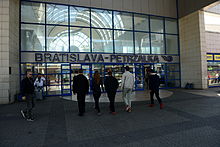
毎時の地域エクスプレスは、 ウィーン ブラチスラバへ。 EURegioチケットは16ユーロでご利用いただけます。往復チケットは4日間有効です。
ポーランドから
から車で一晩があります ワルシャワ チェコの領土を経由してブラチスラバへ。ポーランドからの直通列車の接続は非常に貧弱で、バスが一般的に良い代替手段です。国境を越えて行くローカル列車はほんのわずかです– 1本の列車Zwardoń(PL)–Skalité(SK)。に国際旅客輸送はありません ノビ・ソンチ–プレショフ (2010年12月以降)および ウプクフ-メジラボルツェ ライン(2009年12月以降)。
本当に電車でポーランドから旅行したいのなら、電車の乗り換えが多い一日旅行の準備をしてください。ポーランドのチケットを国境地点(SkalitéGr。)までのみ購入し、スロバキアの国内チケットを車掌で購入する方が安いです(1.30ユーロの追加料金)。
ハンガリーから
からのEC列車があります ブダペスト ブダペストから1日2本のIC列車と2時間ごとに運行しているブラチスラバへ ミシュコルツ に コシツェ。ポーランドからの旅行とは異なり、指揮者でスロバキアのセクションを購入する方が安くはありません。代わりに、60%の二国間返品割引があります(つまり、往復チケットは片道チケットよりも安いです)。
ウクライナとロシアから
から毎日直接寝台車があります モスクワ, キエフ そして リヴィウ コシツェ、ポプラト、ブラチスラバへ。旅は非常に長く、モスクワとキエフから2泊、リボフから1日と夜です。ウクライナ西部の鉄道網の状態、国境での長い通関手続き、ウクライナ間の軌間不連続点(ロシア語でゲージ)およびスロバキア(標準ゲージ)。
ウクライナ国境駅までのウクライナまたはロシアのチケットを購入する方がはるかに安いです チョップ、次にチョップから最初のスロバキア駅までのチケットを購入します ČiernanadTisou、次に指揮者からスロバキア国内チケットを購入します(1.30ユーロの追加料金)。ただし、スロバキアセクションのバース予約はなく、チョップの座席車に変更する必要があります。
もう1つのオプションは、ロシアでCityStarチケットを購入することです(またはスロバキアの方が安い場合)。ただし、これは5人までのグループにのみ有効です。駅間の1か月有効な双方向チケットとしてサーバーよりもCityStarチケットが提供され、チケットの次の乗客ごとに割引が適用されます。もちろん、バースチケットも追加購入する必要があります。
バスで
とりわけ、ウィーン、プラハ、ブダペストからブラチスラバへの定期便があります。とから ウジホロド、ウクライナからスロバキア東部の町ミハロフツェまで クラクフ、ポーランドから ザコパネ、ポーランドからポプラトへ。
プラハからブラチスラバへのバスの利用は、事前にチケットを購入した場合、電車よりも遅くなりますが、安くなります。で スチューデントエージェンシー, スロバキアライン、または共通バス予約システムを使用する AMSBus.
ポーランドとウクライナからのバスが最良の選択肢であり、電車よりも速く、頻繁です。
ブダペストからの所要時間は4時間、バス停はジェールと道路の小さなレストランで5分間です。
車で
スロバキアには、近隣諸国に接続された高速道路ネットワークがあります。
徒歩で
- 車の運転手と歩行者がアクセスできるポンツーンフェリーがあります アンガーンアンデアマーチ (オーストリア)と ZáhorskáVes (スロバキア)。 05:00〜22:00。
移動する
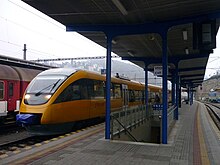
CPは 非常に便利なウェブサイト スロバキアのすべての電車とバスの時刻表が統合されたスマートフォンアプリ。都市内および都市間のすべての交通機関を含み、バスがどの車線から出発するかを示します。スロバキア発着の海外旅行にも便利です。
電車で
自家用車がない場合は、スロバキアを横断するのに電車が断然最良の選択肢です。頻繁な高速列車がすべての重要な都市を結んでいますが、本線でもローカル列車は少なくなっています。地元の交通機関の場合、一般的にバスがより良い代替手段です。電車はかなりの値段で、バスと競争力があり、西洋の基準では安いです。彼らは信頼性が高く、きれいです。
洋風の快適さが必要な場合は、InterCityサービスを選択してください。 IC列車は、ブラチスラヴァ、ジリーナ、ハイタトラス、コシツェを結んでおり、強制予約があります。これらは混雑からあなたを救うことができます:通常の列車は通常金曜日と日曜日または休日の周りに混雑します。主要な駅でスリに気をつけて、お金の詐欺を避けてください。また、一晩はえ縄船を旅行している眠っている乗客に散発的な強盗が発生します。
国内のほとんどの列車サービスはによって提供されています ZSSK、他の列車運行会社は Leo Expres そして レギオジェット どちらも長距離列車を提供し、レギオジェットはブラチスラバと コマールノ.
割引とチケット
- インターネットチケット ZSSKによる -5%割引でクレジットアカウントを使用して購入できます。国内列車の電子形式または印刷形式のインターネットチケットは、選択した列車と日付、または有効初日の同じルート上の次の列車(座席の予約を失った場合)で有効です(すべてのIC列車とEx 1502 Chopokを除く)列車)。駅で購入したチケットは、指定された期間(距離に応じて通常1日または2日)内の特定のルートでの1回の旅行に有効であるため、非常に柔軟性があります。一部の国際チケットは駅でのみ購入できます。ZSSKのウェブサイトで駅が見つからない場合は、対象国の言語(ウィーンの代わりにウィーン、プラハの代わりにプラハなど)を使用してみてください。
- 無料送迎 -市民権や在留資格に関係なく、16歳未満の子供と62歳以上の高齢者。 EU加盟国の市民または永住者である26歳未満の学生および62歳未満の年金受給者(健康障害のある退職を含む)。鉄道会社に登録する必要があります。 2x3 cmのサイズの写真を忘れないでください(最新、未使用、プロフェッショナル、シャープで十分に明るい、正面から描かれ、帽子や背景はありません)。
- KLASIK RAILPLUS ZSSKによる -35ユーロで、標準の国内運賃から1年間25%割引になります。 1年に標準運賃の140ユーロ以上を使う予定の場合は、それだけの価値があります(ブラチスラバ-コシツェの往復チケットは約5枚)。登録には2x3cmのサイズの写真を忘れないでください。クレジットアカウントを使用して5%割引と組み合わせることができます。
- Leo Expres そして レギオジェット 長距離列車-オンラインで事前に予約すると最も安く、特定の列車と時間に関連付けられています。
バスで
バスの接続は通常電車よりも遅いですが、電車が行けない場所に行くことができます。また、一部の民間企業は外国のISICカードを持っている旅行者に割引を提供しています(スロバキア市民でない限り、国営企業は割引を提供していません)。長距離路線のチケット-100km( チェコ共和国 またはチェコ共和国内)から購入できます AMSBus 強制登録後(英語版もあります)。ブラチスラバからへの旅行 ニトラ バスが電車よりも大幅に高速で安価なルートのまれな例です。
バスは時間厳守であるため、事前にバス停に到着することをお勧めします。時刻表に指定されている時間は、駅を出発する時間です。ほとんどのチケットは運転手から直接購入されるので、おそらく現金が必要になります。バスの運転手はあなたに変化を与えますが、特に短い(安い)旅の場合は、いくつかの小さな額面を持っていることをお勧めします。大きな鞄を持っている場合は、少額の追加料金がかかります。
Turancar そして スチューデントエージェンシー 非常に信頼性が高く、快適で(エンターテインメントLCD画面を搭載した新しいバスを頻繁に使用するため)、時間どおりに運行し、ISICを使用する外国人に学生割引を提供する民間バス会社の良い例です。
タクシーで
ライドヘイリングはスロバキアで利用可能であり、以下が最も期待されているプロバイダーです。
車で
道路網は広範で、全体的に良好な状態です。ほとんどの主要道路(特に西部)は2車線であり、良好に修復されていますが、マイナー道路の大部分は1車線であり、この維持基準は良好なものからかなりでこぼこしたものまでさまざまです。主要なルートと高速道路に沿って燃料ストップとレストラン(odpočívadlo または čerpaciastanica)は非常に頻繁にあり、小さな町では、小さなキオスクが見つかる可能性があります(stánok)またはフルーツまたはチーズスタンド(ovocnýstánok 果物のために、 stánoksosyrom チーズの場合)道路の隣にあり、地元の珍味を低価格で提供しています。
スロバキアの運転スタイルは、特に西ヨーロッパの国々と比較して、より攻撃的で低水準です。特に国のより山岳地帯では、他の車がスピードを出し、道路の脇で追い越しをしていることに注意する必要があります。
運転

車両は道路の右側を走行し、制限速度は通常、村/町では50 kmh(31 mph)、市街地の外では90 kmh(56 mph)、高速道路では130 kmh(81 mph)です。ただし、キャラバン/トレーラー付きのトラックや車は、市街地の外や高速道路では80 km / h(50 mph)に制限されており、オートバイは高速道路では90 km / h(56 mph)に制限されています。
車やバンではシートベルトの着用が義務付けられており、11歳以下または150cm未満の子供は後部座席に配置する必要があります。
ヘッドライトは、気象条件や夜間、昼間を問わず、運転中は常にオンにする必要がありますので、オンにしてください。
冬には、道路で雪や氷がよく見られます。冬用タイヤをお勧めします。異常気象では、いくつかの小さな山道でスノーチェーンが必要になる場合があります。
スロバキアはアルコールに対してゼロトレランスポリシーを持っています。飲酒運転しないでください。他に何もないとしても、罰則が厳しいからです。
あらゆるサイズのモーターサイクルでは、ドライバーと同乗者の両方にヘルメットの着用が義務付けられています。また、エンジンが50ccを超えるモーターサイクルのドライバーもゴーグルを着用する必要があります。
警察の存在は、マークされた車両とマークされていない車両の両方で、道路、特に主要道路で頻繁に発生します。
高速道路を運転する場合は、車両に必須のステッカー(ビネット)車のフロントガラスの右上隅にある道路通行料をカバーします(これは主に固定電子カメラシステムによってチェックされるため、必須の場所です)。ビネットはほとんどのガソリンスタンドから購入でき、10日間(10ユーロ)、1か月(14ユーロ)以上有効です。ビネットは、入口からすべての高速道路で義務付けられており、ビネットなしで捕まった場合は罰金が科せられますのでご注意ください。レンタカーを借りる場合は、レンタカーに含まれている可能性が高いですが、レンタル/予約の際は必ず確認または問い合わせてください。
スロバキアを理解しているなら、多くの民間ラジオ局はニュースの一部として素晴らしい交通報道を含んでいます。それは道路の障害物、自動車事故、交通渋滞、さらには警察の存在についてあなたに知らせるので、それは確かに調整する価値があります。と呼ばれるウェブサイトでもあります ステラセントラム、交通と警察のパトロールに関する一般的な情報を見つけることができます(警察のパトロールが実際にどこにあるかを知らせます)。
パーキング
ほとんどの場所で無料駐車場を提供していますが、大都市の中心部では駐車料金がかかる場合があります。ブラチスラバ以外の都市では、有料駐車場の最も一般的な方法は、機械に出入りしてスリップを受け取る閉鎖されたエリアです。途中で、伝票を返却して人に支払う必要があります。その人は英語を話さない可能性が高いですが、あなたが十分に混乱しているように見える場合、彼または彼女はあなたに金額を書いた手書きのメモを渡します。 Try to pay the exact amount with cash, and avoid paying with large bills, as these places rarely have much cash at hand. In central Bratislava you can find places, where you have to get a parking slip from a vending machine and pre-pay for your parking. The slip then has to be placed behind the wind shield of the car and must be visible from the outside.
賃貸
Renting a car is a convenient, efficient and relatively cheap (prices start at approx. €65/day at car rental chains with free mileage) way to explore Slovakia, especially if you intend to visit more remote areas, where train and bus services may be more sporadic. Don't expect neither GPS nor road map to be included and remember to check if highway vignette (see above) is included; it most likely, is but not always. Ask when booking and if it is not, then they can most likely easily include it without any handling charges.
Hitchhiking
Hitchhiking in Slovakia is best done by asking around at gas stations. It used to be that most people only speak Slovak (and possibly understand other Slavic languages) so it was difficult for foreigners who don't speak Slavic languages. However, nowadays most of the young people speak English and almost as many speak German.
Keep in mind that trains and buses in Slovakia are cheap for Westerners, and (apart from extremely rural areas where people are generally less wary of hitchhikers) it might take a while for someone to pick you up. You can find some offers if you travel from Slovakia and into Slovakia as well on specialized web pages. The biggest hitchhikers page in Slovakia is stopar.sk。 There you can find offers in English, German, French, Polish, Czech and Hungarian language and it is free.
徒歩で

There is a long tradition of hiking and mountain walking in Slovakia, and it is an extremely popular sport. Most people you meet will have gone on a hike at least once in their life, and many do so regularly, and can give you advice about the most interesting local trails. The trail network is also very well maintained. The quality and efficiency of the sign-posting system is unique in European (and probably World) context.
Every route is marked and signposted, different trails being given a different colour. There are four colours used - red, blue, green and yellow. Longest and most sternous trails are usually marked red, and it is possible to traverse from north-eastern Dukla Pass all the way to the west (Bradlo, near ブラチスラバ) along the Slovak National Uprising Heroes trail (750 km) along one such red-marked path. However, the trails are numerous, suitable for various levels of fitness, and many lead through beautiful scenery. In towns, you will usually see a signpost, with arrows pointing in different directions, marking the colour of the path and the average walking times to the nearest set of destinations. All you need to do is to follow the colour, there will be a mark every hundred metres or so, and consists of a 10-cm-by-10-cm square three-section mark where the edges are white and the chosen path's colour in the middle.
It is also possible (and highly recommended) to purchase 'tourist maps' of smaller slovak regions. These are based on sets of former military maps, have a very good resolution (1:50000) and can be purchased from most kiosks, information centres and bookstores for bargain price of between €1.50-2.50. These are published by the Slovak Tourist Club (KST), which maintains all the trails, and show all the marked trails in the area, including the average walking times, which makes route planning very easy and efficient. You can also use hiking websites such as Freemap Slovakia (based on Openstreetmap data) or HIKING.SK
トーク
- 参照: スロバキア語集

The official and most widely-spoken language is スロバキア。 Slovaks are very proud of their language, and thus, even in Bratislava you will not find many signs written in English outside of the main tourist areas. In some parts of the country, especially in the east, dialects are used which may sound quite different from the codified language. However, understanding the official language should rarely be a problem and attempts to speak Slovak will be appreciated!
Slovak is written using the same Roman characters that English uses, with some added accents or diacritics, so Western travellers won't have any trouble reading signs and maps. While some words are tongue twisters, the knowledge of the alphabet including the letters with diacritics will go a long way as Slovaks pronounce every letter of a word with the stress always on the first syllable (it may be on the second syllable in some eastern dialects).
チェコ語 and Slovak are mutually intelligible, yet distinctive languages. At first, one might think they are dialects of each other - older people in both countries tend to understand the other language better than younger people who were born after the breakup of チェコスロバキア.
Since the territory of Slovakia was under Hungarian influence for centuries, there is a significant ハンガリー語-speaking minority of 9.7%. Most of the Hungarians live in southern regions of the country and some of them speak no Slovak. Other Slovaks however normally do not speak or understand the Hungarian language.
While you can make do with English and ドイツ人 in Bratislava, in smaller towns and villages they are not as widely spoken, though many younger people are usually able to speak English. Older residents may know some German and Russian, as well as tourist area workers. People born between 1935 and 1980 will have learned ロシア in school, though few Slovaks will appreciate being spoken to in Russian as this language has some negative connotations due to the Communist era, and these days, English has largely supplanted Russian as the most widely taught foreign language. Due to the significant tourism growth in the north and the east of Slovakia, English is becoming more widely used and you may try 研磨。 Other Slavic languages, especially Russian, Serbian, Croatian, and Slovene may also work. In the east Rusyn, an East Slavic language closely related to Ukrainian, is spoken. It is also intelligible with Russian to some extent.
見る

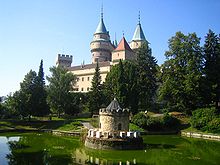

Slovakia combines all the typical features of a grand European history with highly attractive nature and a traveller-friendly modern atmosphere. Its fairly small capital ブラチスラバ may not have the majestic sights you'll find in some other Eastern European capitals, but it has an energetic vibe to it, a lovely Old Town, Bratislava Castle and endless options to have a great time. The city as a whole is a quaint mix of 18th-century rococo and concrete Communist building blocks. An afternoon coffee in one of the countless street cafés along the famous Danube river is an absolute must and a good chance to people-watch and absorb the ambience. For a touch of grandeur, take a river tour down to Devin Castle, an excellent example of Slovakia's record-high number of castles and chateaux。 Some of them are little more than a pile of stones hidden in a deep forest, others are luxurious baroque mansions or citadels in the middle of towns. Other worthwhile examples are スピシュ城 (one of the largest castle sites in all of Europe) and the 19th century Bojnice Castle, a favourite tourism destination for the Slovaks. Almost equally popular is the beautiful Orava Castle 近く Dolný Kubín, high up on a rock overlooking the Orava river. Other good picks for large historic city centres include the old towns of コシツェ, トルナヴァ そして レボチャ. バンスカー・シュティアヴニカ is a fabulously preserved medieval mining town and one of the country's World Heritage Sites. Where Banská Štiavnica mined for silver ore, the smaller but equally well-preserved medieval town of クレムニツァ was built above gold mines and boasts the oldest still-working mint in the world.
If you love nature, Slovakia will be great for you. Large parts of the country are covered with dense forests and the abundance of wildlife includes brown bears, wolves, and lynxes.ザ・ タトラ山脈, more specifically the ハイタトラス, are a prime attraction and offer impressive mountainous panoramas as well as great opportunities for skiing and other outdoor sports. In the large karst areas throughout the country there's an impressive number of 洞窟。 A dozen or so are accessible for tourists.ザ・ Ochtinská Aragonite Cave 近く Rožňava stands out, as it is one of the only three aragyonite caves in the world. Together with other caves of the スロバキアカルスト, it is listed on UNESCO's World Heritage list. If you enjoy hiking, try the スロバキアパラダイス国立公園, famous for its beautiful canyons and ravines with many waterfalls and rocky formations. For a more relaxing encounter with Slovakia's natural environments, head to one of the many mineral springs and spas. ピエシチャニ is one of the best-known ones, but your options are countless.
If you get the chance, travel a bit through Slovakia's countryside. It's dotted with historical villages, sometimes seemingly untouched by time, and often a good way to catch a glimpse of the country's folk traditions.の集落 ヴルコリニェク is considered a prime example of folk countryside architecture, but Čičmany そして Brhlovce are lovely villages too.Historic churches are impossible to miss, as you'll find them in every village, town and city. Especially well-known are the many wooden churches in the northern and north-eastern parts of the country.
購入
お金
ユーロの為替レート 2021年1月4日現在:
為替レートは変動します。これらの通貨およびその他の通貨の現在のレートは、 XE.com |
Slovakia uses the ユーロ, 他のいくつかのヨーロッパ諸国のように。 1ユーロは100セントに分割されます。ユーロの公式記号は€で、そのISOコードはEURです。セントの公式シンボルはありません。
この共通通貨のすべての紙幣と硬貨は、低額の硬貨(1セントと2セント)が一部で段階的に廃止されていることを除いて、すべての国で法定通貨です。紙幣は国を超えて同じように見えますが、硬貨は裏側に標準的な共通のデザインがあり、価値を表現し、表側には国固有のデザインがあります。表側は、記念コインのさまざまなデザインにも使用されます。表側のデザインはコインの使用に影響を与えません。
Until January 1, 2009, the official currency was the コルナ ("crown", sk) which can still be found and accepted by the central bank until 2017 at a rate of 30.126sk to €1.
銀行
Automatic teller machines (ATM, "bankomat" in Slovak, pl. "bankomaty") are widely available in Slovakia except in smaller villages, and obtaining money there should not present a problem. In most of small villages you can gain money at local postal offices (cashback). Credit cards and debit cards such as Visa, MasterCard, Visa Electron, Cirrus Maestro are widely accepted both in shops and restaurants in bigger cities.
チップ
チップ is not compulsory in Slovakia, but in practice it is common in establishments where you sit in (cafes and restaurants), where rounding up the bill or leaving around 10% tip is common. The tip is given directly to the waiter (i.e. tell him/her how much to give you back), not left on the table in most establishments. Tips are not included in the bill, if there is a percentage shown on your bill, this is usually the VAT. Tip is added to the bill and should be handed to the waiter while you pay, before you leave the table. Tipping is not compulsory, so if you are not satisfied with the service, don't feel obliged to tip! You will not be hassled if you don't.
Tipping is not common in over-the-counter establishments, bars or for other services.
食べる
Slovak cuisine focuses mostly on simple and hearty recipes. Historically, what is now considered genuinely Slovak has been the traditional food in the northern villages where people lived off sheep grazing and limited agriculture - in the harsh conditions many crops don't grow, and herbs are more accessible than true spices. Therefore, the staple foods mostly involve (smoked) meat, cheese, potatoes and flour. This does not make the food bland, however, and much of it is quite filling and flavoursome, though can be a bit heavy. As no strong spices or truly exotic ingredients are used, sampling local wares is a safe and rewarding experience.
Some dishes are authentically Slovak, many others are variations on a regional theme. A lot of cheese is typically consumed, out of meats pork and poultry products are the most common, with some beef and game dishes, most common accompaniments being potatoes and various types of dumplings. Since Slovakia is a land-locked country, fish and seafood options are limited (carp is served at Christmas, trout is the most common fish). Soups are quite common both as an appetiser and, as some are quite filling, as a main dish.
あなたが vegetarian, the variety of food in the cities should be decent. However, when venturing out into the countryside, the offer may be limited as vegetables are mostly considered a side and/or eaten mostly raw or in salads. Also, be aware that even though some dishes will be in the vegetarian section of the menu, this merely means that they're not predominantly meat-based and still might be prepared using animal fats or even contain small pieces of meat, so make your requirements clear. Fried cheese with ham or Cesar salad(!) are good examples. Still, almost every restaurant in the country will serve at least the staple choice of fried cheese (the normal, non-ham variety) with fries, which is a universally popular. There should be a good selection of sweet dishes as well, with pancakes, dumplings filled with fruits, jams or chocolate and sweet noodles with nuts/poppy seeds/sweet cottage cheese most common. Seeking out the nearest pizzeria is also a good and accessible option mostly everywhere.
The main meal of the day is traditionally lunch, though this is changing especially in cities due to work schedules, and dinner is increasingly becoming the main meal there.
In all but the most exclusive restaurants it is not customary to be shown to your table by the staff. So when you enter, do not hang out by the door, but simply pick a table of your choice and enjoy. Once you are comfortably seated, waiting staff will be over shortly to give you the menu and let you order drinks.
Again with the possible exception of the most exclusive establishments, there is mostly no dress code enforced in restaurants and informal clothing is fine. Hauling yourself into a restaurant for a well-deserved meal after a day of hiking/skiing in your sporty clothes might attract a few frowns, but you certainly won't be turned away. Generally, anything you would wear for a stroll in town is perfectly fine. You don't need a jacket or closed shoes and in summer shorts are also acceptable.
Slovak food
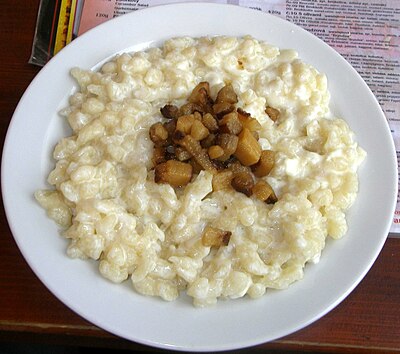
Bryndzové halušky is a Slovak national dish made out of potato dumplings and a special kind of unpasteurized fermented sheep cheese called 'bryndza'. This meal is unique to Slovakia and quite appetising (and surprisingly filling), and you should not leave Slovakia without trying it. Please note that while this dish will usually be listed in the vegetarian section of the menu, it is served with pieces of fried meaty bacon on top, so if you are a vegetarian make sure to ask for halušky without the bacon. Halušky can be found in many restaurants; however, the quality varies as it is not an easy dish to prepare. If you at all can, seek out an ethnic Slovak restaurant (this can be harder than it sounds), or at least ask locals for the best place in the vicinity. In the northern regions you will also find authentic restaurants called 'Salaš' (this word means sheep farm in Slovak and many take produce directly from these), which serve the most delicious and fresh variety. Sometimes, a variety with smoked cheese added on the top is available. A separate dish called strapačky might also be available where sauerkraut is served instead of bryndza, but it is not as typical (this will also come with bacon on top).
A salaš will usually serve also other typical Slovak dishes, and many will offer several varieties of sheep cheese to buy as well. They are all locally produced, delicious, and well worth buying if you are a cheese fan. Verieties include ブリンドザ (primarily used to make 'Bryndzové halušky', but it is a soft spreadable cheese which is very healthy and often used as a spread), blocks of sheep cheese (soft and malleable, delicious on its own or with salt), parenica (cheese curled in layers into a small peelable roll, sold smoked or unsmoked) and korbáčiky (this word means hair braids in Slovak, and korbáčiky are threads of cheese woven into a pattern resembling a basic braid). Some of these cheeses are available to buy in supermarkets as well but these are mass-produced and not as good.
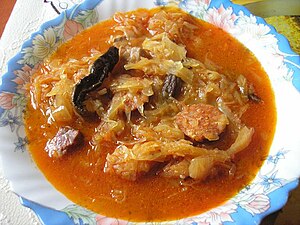
Most other dishes are regional, and their varieties can be found elsewhere in Central Europe.これらには以下が含まれます kapustnica, a sauerkraut soup typically eaten at Christmas but served all year round in restaurants. It is flavoursome and can be mildly spicy based on what sausage is used. Depending on the recipe it may also include smoked meat and/or dried mushrooms.
Various large dumplings called ピエロギ can be found and depending on the filling can be salty or sweet. Fillings include sauerkraut, various types of cheese or meat or simply fruits or jam. They closely resemble Polish pierogi .
Goulash is a regional dish made with cuts of beef, onions, vegetables and squashed potatoes with spices, which is very hearty and filling. Depending on the thickness it can be served as a soup (with bread) or as a stew (served with dumplings). Goulash can be sometimes found outdoors during BBQs or at festival markets, where it is prepared in a big cauldron, sometimes with game instead of beef - this is the most authentic. A variety called Segedin goulash also exists, which is quite distinct and prepared with sauerkraut. Goulash can be quite spicy.
Apart from kapustnica and goulash, which are more of a main dish, other soups are quite popular as an appetiser. Mushroom soup is a typical Christmas dish in many parts, and there are several soups made out of beans or bean sprouts. In restaurants, the most common soups are normal chicken and (sometimes) beef broth, and tomato soup and garlic broth (served with croutons, very tasty, but don't go kissing people after) are also very common. Some restaurants offer certain soups to be served in a small loaf of bread ('v bochniku'), which can be an interesting and tasty experience.
Other typical streetfood 含まれています lokše, potato pancakes (crepes) served with various fillings (popular varieties include duck fat and/or duck liver pate, poppy seeds or jam) and langoš, which is a big deep fried flat bread most commonly served with garlic, cheese and ketchup/sour cream on top. A local version of a burger is also common, called cigánska pečienka (or simply cigánska). This is not made out of beef, however, but instead pork or chicken is used and is served in a bun with mustard/ketchup and (sometimes) onions, chilies and/or diced cabbage. If you are looking for something sweet, in spa cities such as ピエシチャニ, you will find stands selling spa wafers, which are usually two plate-sized thin wafers with various fillings. Try chocolate or hazelnut.
Especially in the western parts, lokše can be found in a restaurant as well, where they are served as side for a roasted goose/duck (husacina), which is a local delicacy.
Other foods worth trying are chicken in paprika sauce with dumplings ('paprikas'), Schnitzel ('Rezeň' in Slovak, very common dish. 'Čiernohorsky rezeň' is a variety that is made with potato dumpling coating used instead of batter and is very good) and Sviečková (sirloin beef with special vegetable sauce, served with dumplings). From the dessert section of the menu, try plum dumplings (sometimes other fruit is used, but plums are traditional); this is a good and quite filling dish on its own as well.
In some parts of the countryside, there is a tradition called zabíjačka, where a pig is killed and its various meat and parts are consumed in a BBQ-like event. This is a lot more historic celebration than you are likely to find in mostly modern Slovakia, but if you have an opportunity to attend, it may be an interesting experience, and the meat and sausages are home-made, delicious and full of flavour. If you can find home-made húrka (pork meat and liver sausage with rice) or krvavníčky (similar to hurka, but with pork blood) on offer elsewhere, they are both very good.もあります tlačenka (cold meat pressed together with some vegetables, served similar to ham), which is served cold with vinegar and onion on top, and can be bought in supermarkets as well. Various other type of sausages and smoked meats are available commercially.
A thick fried slice of cheese served with French fries and a salad is also a common Slovak dish. It is served in most restaurants, and worth trying out, especially the local variety made from smoked cheese ('údený syr'/'oštiepok') or 'hermelín' (local cheese similar to Camembert). This is not considered a substitute for meat.
There is a good variety of bakery products, including various sweet pastries- try the local fillings of poppy seeds and/or (sweet) cottage cheese (tvaroh). Strudel (štrúdla) is also popular, try the traditional apple and raisins filling or fancier sweet poppy seeds and sour cherries version. For something savoury, try pagáč, which is a puff pastry with little pork cracklings. Local bread is excellent, but please note that some of the several varieties are sprinkled with caraway seeds. You may or may not like this! Baguettes and baguette shops/stands are very common and you will be able to choose from a variety of fillings.
For dessert, visit the local cukráreň。 These establishments, though slowly merging into cafes, exclusively specialise in appeasing your sweet tooth and serve a variety of cakes, as well as hot and cold drinks and (sometimes) ice-cream. The cakes resemble similar fare in the Czech Republic or their Viennese cousins. The selection is diverse and on display, so just pick one you like the look of, perhaps a 'krémeš' (a bit of pastry at the bottom, thick filling of vanilla custard, topped with a layer of cream or just chocolate) or 'veterník' (think huge profiterole coated in caramel), selection of tortas etc.
When you are shopping in the supermarket, remember to pick up Tatranky および/または Horalky, two brands of similar wafers with hazelnut filling and lightly coated in chocolate that the locals swear by.
International Cuisine
Italian restaurants and pizzerias are extremely popular in Slovakia, and have become ubiquitous. Even if you don't go to an ethnic Italian restaurant, there will be a pizza or pasta dish on almost every restaurant menu. Italian (and generally Mediterranean)ice cream is also very popular.
Chinese and Vietnamese cuisine is also becoming more common everywhere, and kebab/gyros (a bun with sliced bits of meat) stands are very common.
In bigger cities, you will find a selection of ethnic restaurants including Chinese, Thai, Japanese, Italian, French and many others. Moreover, as mentioned above, many Austrian, Czech, Hungarian and Polish dishes with a Slovakian twist are commonplace.
Fast food establishments can be found in Slovakia as anywhere else in the world, McDonalds can be found in many bigger and smaller cities. However, due to the other food being relatively cheap in comparison to the Western prices of fast foods, this is not usually considered the truly budget option. A food in a cheaper restaurant will cost 1-1.5x the price of a meal combo (sometimes even less) and might prove a better value. Still, these establishments are reasonably popular, especially with the younger generation.
ドリンク
ノンアルコール飲料
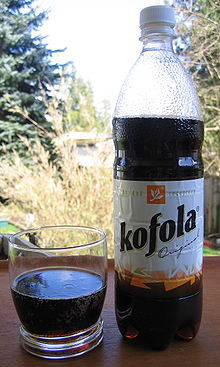
For non-alcoholic drinks try Vinea, a soft drink made from grapes, in both red and white and also non-carbonated. Kofola, a Coke-type soft drink, is also very popular among locals and is available both on tap and bottled. Slovakia is one of three countries in the world where Coca-Cola is not the number one in the market.
Mineral waters are some of the best in the World, come in numerous varieties and each has unique positive health effects (e.g. getting rid of heartburn, improving digestion etc.) depending on the type of minerals naturally found in the water.There are many types available from shops and supermarkets, for example Budiš, Mitická, Slatina, Rajec, Dobrá Voda, Zlatá studňa, Fatra etc. Others are only available directly from the many natural mineral springs common all across the country. As these are true 'mineral' waters, they will invariably contain minerals, and the taste will differ according to the brand/spring. If you don't like one, try a different brand! You may also try mineral waters with various flavourings, ranging from raspberry to 'mojito'.
In contrast to what you might be used to, 炭酸水 is the default option, so if you prefer still you might have to look for this specifically. The level of carbonation is marked by the label. Dark blue or Red label usually indicates carbonated ones ("perlivá"), a green label indicates mildly carbonated ones ("mierne perlivá") and white, pink or baby blue indicates those without carbon dioxide ("neperlivá"). Due to the excellent local choice and quality of the water, international brands are not as common.
In restaurants, serving of a free glass of water is not a part of the culture, so remember that if you ask for one it is quite likely that you will be brought (most likely sparkling) mineral water instead (and charged for it).
Out of hot drinks コーヒー is available everywhere, mostly in three varieties (cafes in cities will offer more) - espresso, 'normal' coffee which is served medium-sized, small and black and Viennese coffee which is 'normal' coffee with a dollop of cream on top. Cappuccinos are quite common as well. Coffee is served with sugar and cream/milk on the side. Hot chocolate is popular as well. お茶 rooms are quite popular as a place to chill out in major cities. These usually have a laid-back, vaguely oriental ambiance, and offer a great variety of black, green, white and fruit teas. Schisha might be on offer as well. A part of this culture spread to the other catering establishments, most of which will now offer a choice at least between fruit and black tea. Note that black tea is served with sugar and lemon in Slovakia, serving of milk or cream is not common. Some places may offer a beverage called 'hot apple', which tastes a bit like softer hot apple juice.
アルコール飲料
Drinking is very much a part of the Slovak culture and some form of alcohol will be served at most social occasions. However, the locals mostly hold their liquor well and であること visibly drunk is frowned upon, so be aware of your limits. Note that some locally brewed spirits may be stronger than what you are used to, and that the standard shot glass in Slovakia is 50ml, which may be more than you are used to if arriving from Western Europe. If you order double vodka, you will get 1dl of it! Alcohol in general is cheap compared to Western Europe or the US. There are no special shops, and alcoholic beverages can be purchased in practically any local supermarket or food store. You can legally drink and purchase alcohol if you are 18 years or older, but this is not very strictly enforced. You still might be IDed in some city clubs if you look very young, however.
にとって ビール, there are a great variety of excellent local brews that are similar in style and quality to Czech beers (which are also widely available), and beer is mostly the local drink of choice. Try out the Zlatý Bažant, Smädný Mních, Topvar そして Šariš。 Šariš is also available in a dark version that is thicker and heavier on your stomach. If the local tastes do not satisfy, "Western" beers are sold in the bigger restaurants and pubs.
Slovakia has also some great local ワイン, many similar to Germanic Riesling styles. There is a number of wine-growing regions in the south with centuries worth of tradition, including the area just outside Bratislava. If you can, try to visit one of the local producer's wine cellars, as many are historical and it is a cultural experience as of itself. You might also be offered home-made wine if you are visiting these areas, as many locals ferment their own wines. The quality obviously varies. Every year at the end of May and beginning of November, an event called Small Carpathian Wine Road takes place in Small Carpathian Wine Region (between ブラチスラバ そして トルナヴァ), where all the local producers open their cellars to the public. Buy a ticket in the nearest cellar and you will receive a wine glass and admission into any cellar in the region, where you can sample the best produce from the previous year.
There are also sweeter wines grown in South-Eastern border regions called Tokaj。 Tokaj is fermented out of the special Tokaj grape variety endemic to the region (part of which is in Hungary and part in Slovakia) and it is a sweet dessert wine. Tokaj is considered a premium brand with a world-wide reputation and is arguably some of the best Central Europe has to offer. Other Slovak wines might not be widely known outside the region but they are certainly worth a try. Around the harvest time in the autumn, in the wine-producing regions, young wine called burčiak is often sold and popular among the locals. As burčiak strengthens with fermentation (as it becomes actual wine), its alcohol content can vary quite wildly.
Slovakia produces good スピリッツ。 Excellent is the plum brandy (Slivovica), pear brandy (Hruškovica) or herb liquor Demänovka。 But the most typical alcohol is Borovička, a type of gin.チェコ語 Fernet, a type of aromatic bitter spirit is also very popular. In some shops you may try a 25 or 50 ml shot for very little money, so as to avoid buying a big bottle of something of unknown flavour, then decide whether to buy or not to buy. International brands are also available, but at a price premium (still cheaper than in most Western countries, however).
If you are a more adventurous type, you can try some home-made fruit brandys that the locals sometimes offer to foreigners. Slivovica is the most common, but also pear brandy, apricot brandy, or raspberry brandy can be found. Drinking is a part of the tradition, especially in the countryside. If you are visiting locals, don't be surprised if you are offered home-made spirit as a welcome drink nor that the host may be quite proud of this private stock. The home-made liquors are very strong (up to 60% alcohol), so be careful. If Slivovica is matured for 12 or more years, it can become a pleasant digestive drink.
In winter months, mulled wine is available at all winter markets and mulled mead is also common. A mixed hot drink called grog, which consists of black tea and a shot of local 'rum' is very popular, especially in the skiing resorts, and really warms you up.
行う
_-_ulica_Andreja_Kmeťa.jpg/300px-Banská_Štiavnica_(Selmecbánya,_Schemniz)_-_ulica_Andreja_Kmeťa.jpg)
- Visit the nearest chateau/castle - many are hundreds of years old, some preserved in a habitable state with period furnishings and many guided tours are offered.
- ハイキングに行く! - the entire Slovakia (except flatlands) is covered with hundreds of miles of extremely well-marked hiking trails, that especially in the national parks lead though gorgeous landscapes. Get the idea ここに.
- Visit one of the traditional wooden churches, they're unique to the region. These might not be readily accessible without a car, however.
- Go spelunking - caves are interspersed around Slovakia and as many are open to general public they are some of the most accessible in the world. Many are UNESCO listed, including Dobsinska Ice Cave (in Slovak Paradise), and Ochrinska Aragonite Cave, Domica, Jasovska Cave そして Gombasek Cave (all in Slovak Karst)

- Visit a local festival - in the early spring 'Fasiangy' (Mardi Gras) is celebrated, especially in the countryside, and in early autumn the end of the harvest period is celebrated in wine-producing regions. The part of the centre of the town will be closed and a traditional market available, mostly with local produce and handicrafts for sale and plenty to eat and drink. In bigger cities, similar Christmas markets open in December/around Christmas.
- Ski and snowboard in the mountains, especially ハイタトラス そして 低タトラ。 Smaller ranges are also very suitable for cross-country skiing
- Navigate down the rivers Váh or Dunajec on a raft through picturesque gorges. For a more gentle ride, raft down the Small Danube.
- If you're into railway history or would like to spend a day romantically, Slovakia offers a number of phased-out railway tracks, which were once used for transporting wood, but now transport only tourists in cosy steam trains through forests and valleys. The best-preserved of them all is ČHŽ near the town of Brezno.
- Slovakia offers many excellent spas. If you enjoy stinking mud and are willing to pay for it, the best, most famous (and most expensive) spa is located in ピエシチャニ。 Important spas are also in Trenčianske Teplice, RajeckéTeplice, Bardejov, Dudince そして Podhájska.
- If the above is too sedate for you and you'd welcome some water slides and fun, try water parks in Bešeňová, リプトフスキーミクラシュ, ポプラト, Turčianske Teplice, Oravice, Senec。 Significantly cheaper are classical open-air pools, some of the best are in Veľký Meder そして Štúrovo.
Cultural events
- International Film Festival Artfilm. Yearly in June/July in Trenčianske Teplice そして トレンチーン.
- International Film Festival Cinematik. Yearly in early September in ピエシチャニ。 Young and relatively small film festival. Accreditation for the whole festival is less than €7.
- International Film Festival Bratislava. Forever in December.
- Comics-Salón - A event dedicated to Japanese Anime & Manga, Fantasy and SciFi and its fans, but not only them! Great atmosphere, friendly folk and lots of fun awaits you there. This events roots stretch back to 2004, when it was held in "Súza" for the first time. Now, once every year early in September ブラチスラバ enjoys the rush of fine individuals from all over Europe to participate in this unique event. For the past 2 years, the location was moved to "Istropolis" exhibition halls due to space constraints.
Music events
- Pohoda Music Festival. One of the biggest Slovak music festivals, critically acclaimed and recognised on European scale. Yearly in July in トレンチーン。 Hosts mostly alternative music.
- Grape Music Festival. Another great smaller alternative music festival. Yearly in August in ピエシチャニ.
睡眠
There is a wide range of accommodation available in Slovakia. These range from AquaCity, based in Poprad, through to budget priced rooms in rental chalets.
The most luxurious hotels can mostly be found in major cities such as Bratislava and Košice and in the major tourist destinations like the High Tatras or the spa towns (the situation here is unique as the price of the hotel usually includes some of the spa procedures). These hotels offer Western style comfort and prices.
There will be at least one hotel available in every major town or tourist area, but the quality varies. Some of the mid-range hotels were built during the Communist era in the corresponding architecture style, which might make them look less appealing from the outside, though the interiors might be perfectly adequate.
Budget hostels are mostly concentrated in the major cities, and you can expect typical hostel prices as in the rest of (Central) Europe. If you are venturing outside of cities, there are numerous mountain huts available for short-term rent in the mountain areas. Especially in touristy areas there will be many private rooms available for rent, look out for 'Zimmer Frei' signs. This typically does not include breakfast.
When hiking, official maintained mountain cabins offer cheap accommodation for hikers on trails in all of the national parks and a lot of the national conservation areas. They have a limited number of beds (if any) and generally limited capacity, so for the more frequented places during the high season an advance booking might be necessary and is recommended. If you don't manage to book a bed, you might be allowed to still stay overnight, sleeping on the floor in designated areas. Either way, you will probably want to bring your own sleeping bag. The facilities, due to the location, are limited, but there will be a shared toilet and possibly a shower. There's usually a kitchen that serves several hearty hot dishes and a number of drinks at pretty reasonable prices.
It is only legal to pitch a tent in Slovakia outside national parks and propected natural zones (where should be signposts but there might not depending on how and where you enter these), but camping is reasonably popular in summer.Camping grounds in Slovakia (non-exhaustive list):
| 名前 | 領域 | ロケーション | 住所 |
|---|---|---|---|
| Camping Bojnice[リンク切れ] | Bojnice | Kopálková Silvia | |
| ATC Zlaté Piesky | ブラチスラバ | Senecká cesta 2 | |
| Autocamping Bystrina | Demänovská Dolina | ||
| Tília kemp Gäceľ | Dolný Kubín | Gäceľská cesta | |
| Camping Kamzík | Donovaly | ||
| Autocamping Margita a Ilona | Levice-Kalinciakovo | ||
| Autokemp Levocska'Dolina | Levoca | ||
| Autocamping Oravice | Liesek | ||
| Autocamping Turiec s.r.o. | マーティン | Kolóna Hviezda c. 92 | |
| Autocamping Slnava II | Piestany | ||
| Autocamping Lodenica | Piestany | ||
| Autocamping Tajov | Tajov | ||
| Eurocamp FICC[リンク切れ] | TatranskáLomnica | ||
| Intercamp Tatranec | TatranskáLomnica | Vysoké Tatry 202 | |
| Autocamping Na Ostrove | トレンチーン | ||
| Autocamping Trusalová | Turany | ||
| Autocamping Varín | Varin | ||
| Autocamping Vavrisovo | Vavrisovo |
学ぶ
多くのスロバキア語コースおよび/または家庭教師がほとんどの主要都市で利用できるはずです。
国内には高等教育のための優れたセンターがいくつかあり、コースは英語で提供されています。これも コメンスキー大学 に ブラチスラバ、スロバキアで最も古く、最も権威のある大学と PavolJozefŠafárik大学 に コシツェ, マテイベル大学 に バンスカービストリツァ そしてその スロバキア工科大学 ブラチスラバで。スロバキアでの勉強についての詳細は見つけることができます ここに[リンク切れ].
作業
スロバキアは欧州連合の加盟国であるため、他の加盟国の市民である場合は、制限なしにスロバキアに合法的に居住し、働くことができます。求人情報の最も人気のあるウェブサイトは profesia.sk
ほとんどの大使館事務所は、欧州市民にもアドバイスを提供します。 2017年の平均給与は月額944ユーロでした。最も給与が高いのは、平均給与が月額1500ユーロを超えるIT専門家です(建設労働者は月額約560ユーロ、ウェイターは月額340ユーロ)。
EU域外からの場合、スロバキアで働くにはビザが必要です。詳細については、スロバキア大使館または大使館に問い合わせることをお勧めします。第二言語として英語を教えることは人気のある仕事の選択肢です。英語/ドイツ語が行う可能性のある国際企業や同様の組織で特定のポジションに応募する場合を除き、他のほとんどの仕事にはスロバキア語の実務知識が必要になる可能性があることに注意してください。
おげんきで
スロバキアは一般的に安全です、ヨーロッパの基準でさえ、そして訪問者としてあなたはどんな問題にも遭遇することはほとんどありません。暴力犯罪は特にまれであり、スロバキアでは多くのヨーロッパ諸国よりも一人当たりの暴力犯罪が少ないと見ています。しかし、旅行者にとって最大の恐怖はおそらく 道路.
道路は一般的に照明が不十分で、非常に狭いです。あなたが運転することを計画しているなら あなたはアルコールの影響下にあるべきではありません。 そのような行為に巻き込まれた場合、罰則は非常に厳しくなります。
緊急の場合は、ユニバーサル緊急番号112に電話してください。警察の場合は、158、救急車155、消防士150に電話できます。
言及する必要はありません 2006年映画ホステル、そのプロットは「スロバキア」で行われます フィクションの完全な作品です、そして観光客が誘拐され拷問される可能性は、スロバキアでも米国や西ヨーロッパの先進都市と同じであり、天文学的に低いです。スロバキアは、ヨーロッパの多くと同様に、すべての観光客にとって安全な旅行先と見なされています。同様に、アメリカ映画 ユーロトリップ (2004)は、スロバキアを恐ろしく未開発の国として描写しているため、デリケートなトピックを証明する可能性がありますが、これも誤りです。
都市を訪れるときは、他のヨーロッパの都市と同じように注意してください。常識を働かせ、暗くなった後は特に注意し、周囲に気を配り、持ち物を視界に入れ、酔っぱらいや若い男性のグループを避けてください。スリは、大勢の人や主要な電車やバスの駅で見つかることがあります。
スロバキアの山岳地帯、特に ハイタトラス、ホテルの担当者または他の信頼できる人にあなたがどこに向かっているのかを正確に知らせてください。そうすれば、あなたが戻ってこない場合に救助隊があなたを見つけるために派遣されます。ハイタトラスの比較的小さな面積と高さは非常に欺瞞的です-それは予測できない天気で急で難しい地形です。一人でハイキングしたり、適切なギアを使用したりしないでください。山岳救助サービスは、追加の最新情報の良い情報源です。彼らの警告を真剣に受け止めてください。緊急の場合は、18300またはユニバーサル112に電話して連絡することができます。アクセスできない地形での救助任務は費用がかかる可能性があるため、出かける前に医療保険に山岳活動が含まれていることを確認してください。
また、ハイタトラスの天気は、特に春と秋に突然変化する傾向があることに注意してください。
スロバキアはヨーロッパに残された数少ない国の1つであり、 クマ そしてオオカミはまだ野生に住んでいます。過去100年間、熊の攻撃で死亡した人は誰もいませんが、毎年数回の攻撃が発生しています。観光客として出会う可能性は非常に低いですが、その可能性はあります。クマはあなたがそこにいることを知っていればあなたを避けます。そのため、これを避ける最善の方法は、特に声を出して話したり、歌ったり、拍手したりして、あなたの存在を知らせることです。距離。クマを見かけたら走らないで、ゆっくりと反対方向に出てください。ホテルから1つ(おそらくゴミ箱から餌をやる)を見つけた場合は、もう少し一般的ですが、それでも可能性は低いですが、近づいたり餌を与えたりしないでください。
健康を維持する

スロバキアを訪れたり滞在したりするのに予防接種は必要ありませんが、田舎を訪れる予定がある場合はダニの予防接種をお勧めします。また、すべてのヨーロッパ諸国と同様に、A型肝炎と「B」型肝炎の予防接種をお勧めします。
ダニ 田舎の森や時には大きな公園で見つけることができ、いくつかの地域ではそれらが運ぶかもしれません ダニ媒介性脳炎。彼らは茂みや背の高い草の中に住んでいるので(彼らが木から落ちるとき)。したがって、ハイキングに行くときは、厚い下草を避け、戻ったときは常に全身をチェックしてください(ダニは暖かい場所を探す傾向があります)。ダニの頭をかみ傷からそっと小刻みに動かして、できるだけ早くダニを取り除きます(頭が皮膚に留まり、感染する可能性があるため、体を壊したり絞ったりしないでください)。いかなる段階でも素手でダニに触れないでください。ピンセットとラテックス手袋を使用してください。
ほとんどの食べ物や飲み物は完全に安全です。スロバキアの衛生基準は西ヨーロッパ/中央ヨーロッパの他の場所と同じです。
水道水 どこでも飲める-ある研究によると、ブラチスラバ-ウィーン地域で水道水として使用されている水は世界で最もきれいです。スロバキアには一人当たりの天然ミネラルウォーターの湧き水が最も多い可能性があるため、ミネラルウォーターを好む場合は、多数のブランドから選択できます。
ハイタトラスは最大または最も高い山脈ではないかもしれませんが、いくつかのトレイルは激しい登り、岩の多い地形を特徴とし、天気は予測できないことが判明する可能性があります。適切な装備を取り、自分の能力を過大評価しないで、常識を働かせてください。
多くの地元の人々がそうであるように、地元の川/自然のプール/湖で泳ぐことにした場合、特に明記しない限り、これらの活動はライフガードによって監督されておらず、あなた自身の責任で行っていることを忘れないでください。
医療水準はかなり高いですが、英語を話す医師が少ないため、言語の壁が問題になる可能性があります。ただし、これは主要な町では問題にならないはずです。 Fakultnánemocnica.
スロバキアのスーパーマーケットやドラッグストアでは市販薬は販売されていません。アスピリンが必要な場合でも、薬局に行く必要があります。さらに小さな都市では、24時間年中無休で営業しているはずです。最も近い緑色の十字の標識に注意してください。この特定の薬局が閉鎖されている場合でも、ドアの標識は最も近い開いている薬局に向かってあなたを示します。特定の薬が必要な場合は、多くの薬がそれを必要とするので、処方箋を用意してください。
尊敬
.jpg/220px-Gorkého_ulica_-_panoramio_(2).jpg)
スロバキアは、自由な民主主義国家に住む友好的で平和な人々です。敵意や本当の問題を引き起こすような問題は1つもありません。通常、起こりうる最悪の事態は、あなたが少しつまらないと思われ、歴史が別のビールについてあなたに説明されることです。ただし、特定のトピックについて話し合うときは、敬意を持って敏感にすることが重要です。
スロバキアは、チェコスロバキアがスロバキア共和国とチェコ共和国に分割された1993年以来独立している独立した国であることを忘れないでください。また、その歴史のほとんどはオーストリア・ハンガリー帝国やチェコスロバキアなどの他の多民族国家の一部であったため、「若い国」でもあります。したがって、国籍の問題に関しては敏感な人もいるかもしれません。チェコスロバキアを分裂させたベルベットの離婚に関しては、敵意や恨みはなく、両国は非常に友好的であり続けています。スロバキアを別の州の一部として言及しないでください。大丈夫です。
第二次世界大戦中のスロバキアの立場は非常に複雑であり、ナショナリストと話すときはこのトピックを避けるのが最善です。同様に、何十年にもわたる共産主義は国にその痕跡を残し、これはデリケートなトピックになる可能性があります。スロバキアは、以前はソビエト圏の一部でしたが、ソ連やロシア帝国の一部ではありませんでした。これを覚えておいてください。
ナチス式敬礼の使用は、スロバキアでは刑事犯罪です。
ロマ/ジプシーの少数派との関係は時々緊張し、一部の人々はこの主題について強い見解を持っているかもしれません。あらゆる種類の会話や討論に入る前に、スロバキアのマイノリティの状況について自分自身を教育してください。
スロバキア人はとても親切で、もし彼らがあなたを彼らの家に招待するなら、よく世話をされ、様々な食べ物や飲み物を提供することを期待してください。昼食に招待された場合は、夕食と同じように2〜3コースの食事を期待してください。これは、昼食が伝統的にその日のメインディッシュであるためです。ワインやグッドスピリットのボトル、チョコレートの箱、小さな花束など、ホストへのささやかな贈り物を持参することは礼儀正しいと考えられていますが、あなたが支払おうとしていると感じられるので決してお金を与えないでくださいおもてなしのために。
ほとんどの人は衛生上の理由で屋外の靴を室内で使用しないので、誰かの家に入るときは廊下で靴を脱いでください。心配しないでください、彼らはあなたの足を暖かく保つためにあなたにスリッパの予備のペアを見つけるでしょう。
ホストの家族と一緒にレストランで食事をするときは、彼らが請求書を選ぶのが通例です。これは起こらないかもしれませんが、起こっても驚かないでください。
異性であっても、初めて誰かに紹介されたり会ったりするときは、握手する代わりに、頬で1、2回(地域によって)キスすることも珍しくありません。 2人の男性の間では一般的ではありませんが、女性にとってはごく普通のことです。心配しないでください。これは性的なジェスチャーではないことを忘れないでください。
接続する
スロバキアの国際電話コードは421です。
緊急の場合は、ユニバーサル番号112に電話してください。消防隊の場合は150、医療緊急の場合は155、警察の場合は158に直接電話することもできます。
スロバキアの電話はで動作します GSM規格、国のほとんどをカバーし、3Gは地域のほとんどをカバーしています。カバレッジは驚くほど良く、深い峡谷にいない限り、山岳地帯でも信号が届くことがよくあります。 Orange、T-mobile、O2の3つの主要なオペレーターがあり、それらはすべて900または1800Mhz標準を使用しており、1900Mhzで動作する一部の米国の電話と互換性がない可能性があります。
それらはすべて(最大のものがFunfónとTesco Mobileであるいくつかの仮想オペレーターと共に)、さまざまな「従量制」スキーム(最良の取引が必要な場合はいくつかの市場調査が推奨されます)とインセンティブを備えたさまざまなプリペイドカードを提供します。ロック解除された電話をお持ちの場合、これらはどの電話ショップでも簡単に手に入れることができます。または、プリペイドカードが含まれている安価な電話を購入することもできます。
まだいくつかの電話ボックスが利用可能ですが、携帯電話が今では当たり前になっているため、その数は減少しています。また、一部を使用するにはプリペイドカードの購入が必要になる場合があることにも注意してください。
Wifiとブロードバンドは多かれ少なかれどこにでもあり、小さな町でもどこかにインターネットカフェ/ゲームルームがあります。また、ホステル、パブ、カフェ、および図書館や政府の建物などの一部の公的機関は、(無料の)Wi-Fiを提供しています。
対処
すべての外国大使館は、市内の旧市街にあるブラチスラバにあります。 A スロバキアの大使館のリスト 連絡先情報は国のウェブサイトで見つけることができます。あなたの母国がスロバキアに大使館を持っていない場合、最寄りの大使館はおそらくオーストリアのウィーンにあり、ブラチスラバから電車、ボート、バス、または車で簡単にアクセスできます。


